Module 9 Population Unit 3 Grammar 课件 (共19张PPT,含内嵌音频) 2024-2025学年英语外研版八年级上册
文档属性
| 名称 | Module 9 Population Unit 3 Grammar 课件 (共19张PPT,含内嵌音频) 2024-2025学年英语外研版八年级上册 | 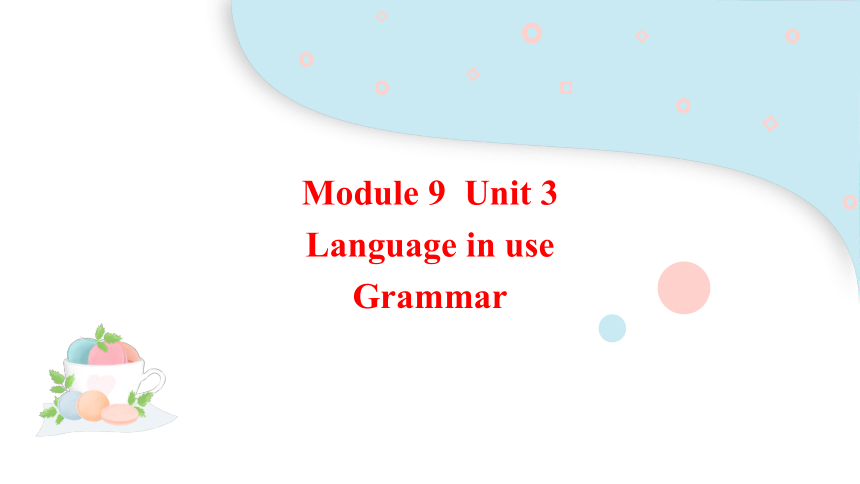 | |
| 格式 | pptx | ||
| 文件大小 | 3.6MB | ||
| 资源类型 | 教案 | ||
| 版本资源 | 外研版 | ||
| 科目 | 英语 | ||
| 更新时间 | 2024-07-20 10:06:23 | ||
图片预览

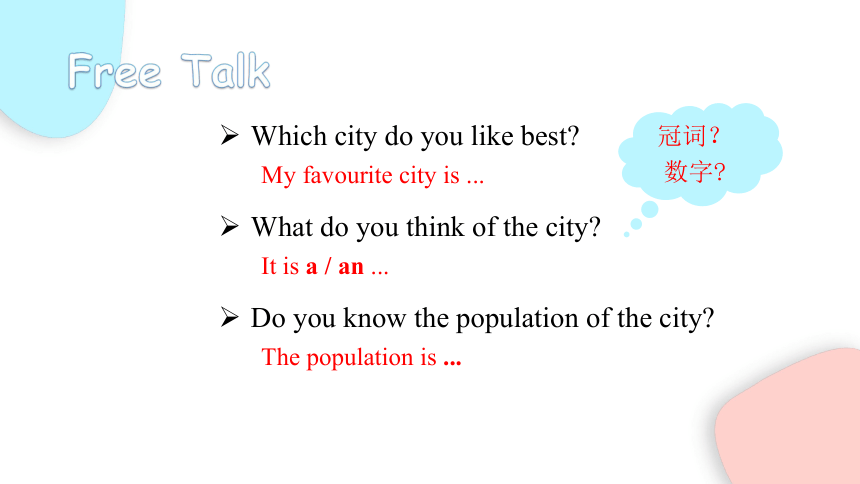

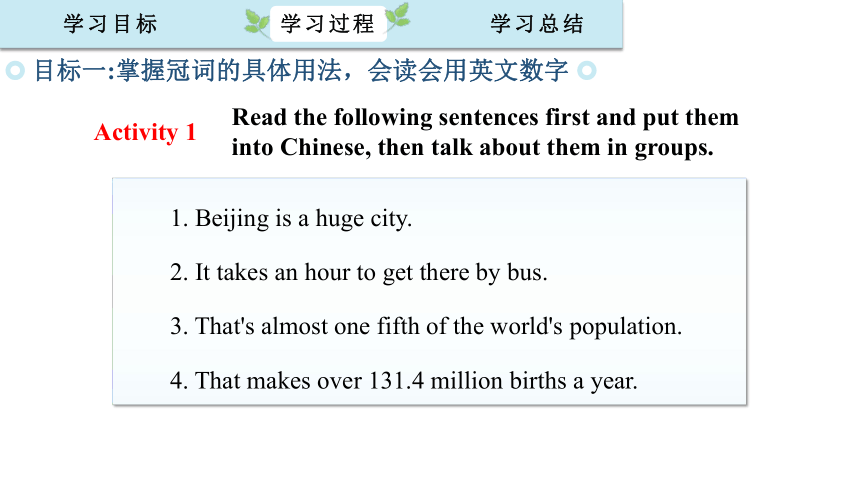
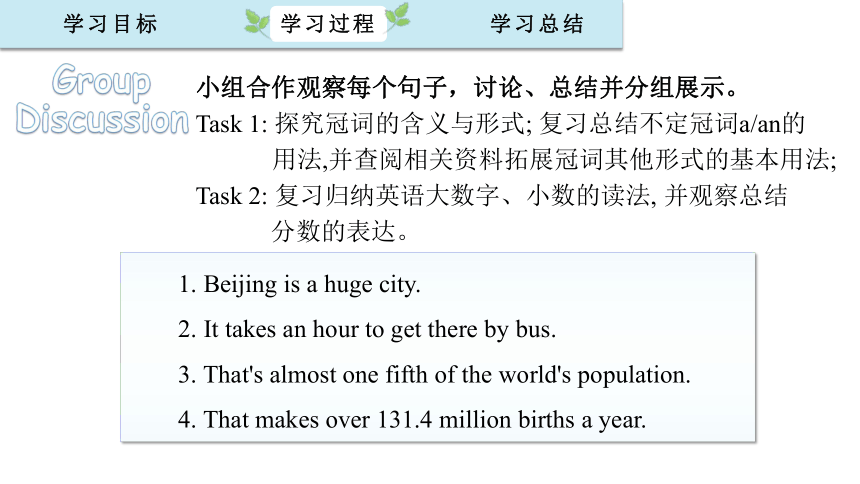
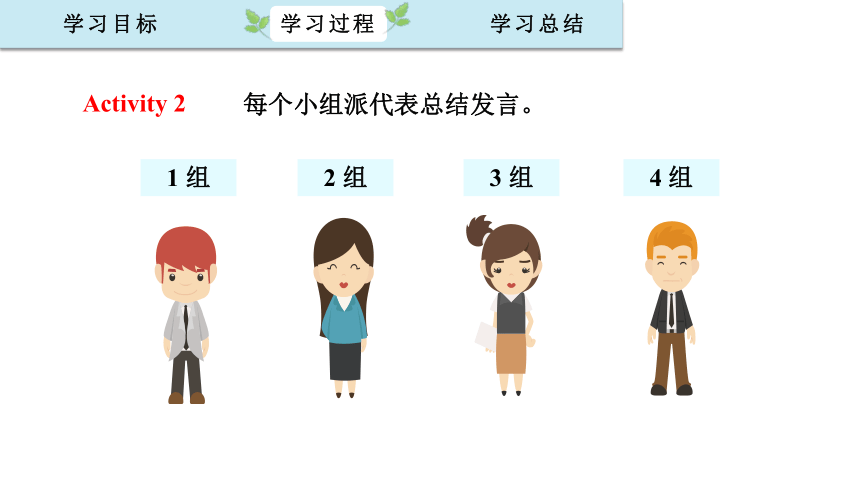
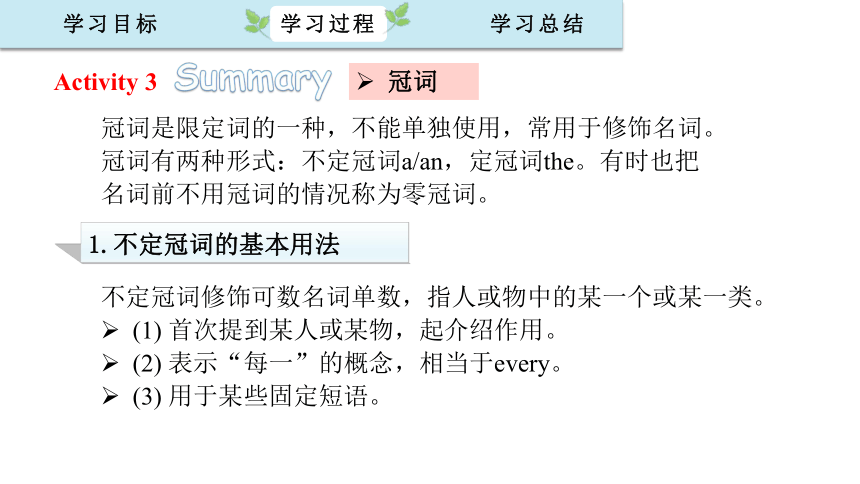
文档简介
(共19张PPT)
Module 9 Unit 3
Language in use
Grammar
Which city do you like best
What do you think of the city
Do you know the population of the city
Free Talk
My favourite city is ...
It is a / an ...
The population is ...
冠词?
数字
1
2
能掌握冠词的具体用法,并会读会用
英文数字。
能正确使用冠词,并能读取表格中的
数字信息谈论人口问题。
目标一:掌握冠词的具体用法,会读会用英文数字
Activity 1
Read the following sentences first and put them
into Chinese, then talk about them in groups.
1. Beijing is a huge city.
2. It takes an hour to get there by bus.
3. That's almost one fifth of the world's population.
4. That makes over 131.4 million births a year.
Group
Discussion
小组合作观察每个句子,讨论、总结并分组展示。
Task 1: 探究冠词的含义与形式; 复习总结不定冠词a/an的
用法,并查阅相关资料拓展冠词其他形式的基本用法;
Task 2: 复习归纳英语大数字、小数的读法, 并观察总结
分数的表达。
1. Beijing is a huge city.
2. It takes an hour to get there by bus.
3. That's almost one fifth of the world's population.
4. That makes over 131.4 million births a year.
Activity 2
每个小组派代表总结发言。
1 组
2 组
3 组
4 组
Activity 3
Summary
冠词
1.不定冠词的基本用法
冠词是限定词的一种,不能单独使用,常用于修饰名词。
冠词有两种形式:不定冠词a/an,定冠词the。有时也把
名词前不用冠词的情况称为零冠词。
不定冠词修饰可数名词单数,指人或物中的某一个或某一类。
(1) 首次提到某人或某物,起介绍作用。
(2) 表示“每一”的概念,相当于every。
(3) 用于某些固定短语。
2.定冠词的基本用法
(1) 指前面提到过的人或物,或特指某人或某物。
e.g. I have a pet dog. The dog is black.
(2) 指谈话双方都知道的人或物。
e.g. Look at the white dress. How beautiful!
(3) 用于序数词以及形容词的最高级之前。
e.g. China has the largest population in the world, and India has the
second largest population.
(4) 用于世界上独一无二的事物。
e.g. The sun is bigger than the earth.
(5) 在江河、海洋、山脉等地理名词前及由普通名词构成的专有
名词前。
e.g. the Great Wall of China长城 the Pacific Ocean 太平洋
2.定冠词的基本用法
(6) 用于表示方位的名词前。
e.g. Guangdong is in the south of China.
(7) 用于乐器名词的前面。
e.g. The boy enjoys playing the violin.
(8) 在某些形容词前加定冠词,表示一类 人或物。
e.g. the rich 富人 the poor 穷人 the young 年轻人 the old 老年人
(9) 在姓氏复数形式之前, 表示“一家人”或“夫妇两人”。
e.g. The Browns have been to China.
(10) 用于某些固定短语中。
e.g. by the way 顺便问一下 in the morning 在上午
3.零冠词的基本用法
(1) 在球类活动、学科名称前,以及节日、月份、星期前不用冠词。
e.g. We have Chinese, English and history on Monday.
(2) 名词前已有指示代词、物主代词、不定冠词或数词等作定语的名词前不用冠词。
e.g. We have several questions to ask.
(3) 在某些固定词组和习惯用语中不用冠词。
e.g. by bus 乘公共汽车 at night 在晚上 in danger 处于险境
【注意】
有些名词前加冠词或不加冠词,所表示的意义不同。
(1) at table 在吃饭 at the table 在桌子旁
(2) in class 在上课 in the class 在班里
(3) in front of 在…的前面 (外部)
in the front of 在…的前部(内部)
Summary
数字
1.大数字
2.小数
从右到左,将数字每三位数看作一个单位,用逗号隔开。
读数字时从左向右,按划分的单位依次读出。
小数中的点读作point,点之后的数字单个独立。
读数字时从左向右依次读出。
3.分数
分子用基数词表示,分母用序数词表示。
当分子大于一时,分母用复数形式。
e.g. one tenth 十分之一 two fifths 五分之二
【注意】
表达分数时有几个特例:a half 一半;二分之一
a quarter 四分之一
three quarters 四分之三
【拓展】 20% 20 percent
目标二:能正确使用冠词,并能读取表格中的数字信息谈论人口问题
Activity 1
4
Complete the passage with a, an or the where necessary.
Mina is (1) ___ eighteen-year-old girl. She’s got (2) ___ brother and (3) ___ sister. Mina is (4) ___ oldest child in (5) ___ family. She lives in (6) ___ very big city. She has (7) ___ job in (8) ___ hotel. She hopes that one day she will have (9) ___ chance to go to (10) ___ college.
an
a
a
the
the
a
a
a
a
/
Activity 2
1
Work in pairs. Match the countries with their populations.
1. China
2. the US
3. Australia
4. New Zealand
a) 4,437,000
b) 22,956,000
c) 314,791,000
d) 1,370,537,000
2
Read your answers to Activity 1 to the whole class.
China has a population of...
Now listen and check.
Activity 3
3
Read the chart and answer the questions.
When you see a table or a chart, look carefully at the labels(标签) and graphs(图表) to make sure that you understand what they are showing. Look at the chart below. What is it comparing What can you conclude(推断出)
Learning to learn
1. Which city had the largest population in 2000
2. Which city's population will increase the most from
2000 to 2025
3. Which city will have a larger increase in its population,
New York or Mexico City
4. Which city/ cities do you think will have the biggest
population problem Why
Tokyo.
Mumbai.
Mexico City.
综合上述目标,说说我们今天的收获。
学习目标
1
2
能掌握冠词的具体用法,并会读会用
英文数字。
能正确使用冠词,并能读取表格中的
数字信息谈论人口问题。
Module 9 Unit 3
Language in use
Grammar
Which city do you like best
What do you think of the city
Do you know the population of the city
Free Talk
My favourite city is ...
It is a / an ...
The population is ...
冠词?
数字
1
2
能掌握冠词的具体用法,并会读会用
英文数字。
能正确使用冠词,并能读取表格中的
数字信息谈论人口问题。
目标一:掌握冠词的具体用法,会读会用英文数字
Activity 1
Read the following sentences first and put them
into Chinese, then talk about them in groups.
1. Beijing is a huge city.
2. It takes an hour to get there by bus.
3. That's almost one fifth of the world's population.
4. That makes over 131.4 million births a year.
Group
Discussion
小组合作观察每个句子,讨论、总结并分组展示。
Task 1: 探究冠词的含义与形式; 复习总结不定冠词a/an的
用法,并查阅相关资料拓展冠词其他形式的基本用法;
Task 2: 复习归纳英语大数字、小数的读法, 并观察总结
分数的表达。
1. Beijing is a huge city.
2. It takes an hour to get there by bus.
3. That's almost one fifth of the world's population.
4. That makes over 131.4 million births a year.
Activity 2
每个小组派代表总结发言。
1 组
2 组
3 组
4 组
Activity 3
Summary
冠词
1.不定冠词的基本用法
冠词是限定词的一种,不能单独使用,常用于修饰名词。
冠词有两种形式:不定冠词a/an,定冠词the。有时也把
名词前不用冠词的情况称为零冠词。
不定冠词修饰可数名词单数,指人或物中的某一个或某一类。
(1) 首次提到某人或某物,起介绍作用。
(2) 表示“每一”的概念,相当于every。
(3) 用于某些固定短语。
2.定冠词的基本用法
(1) 指前面提到过的人或物,或特指某人或某物。
e.g. I have a pet dog. The dog is black.
(2) 指谈话双方都知道的人或物。
e.g. Look at the white dress. How beautiful!
(3) 用于序数词以及形容词的最高级之前。
e.g. China has the largest population in the world, and India has the
second largest population.
(4) 用于世界上独一无二的事物。
e.g. The sun is bigger than the earth.
(5) 在江河、海洋、山脉等地理名词前及由普通名词构成的专有
名词前。
e.g. the Great Wall of China长城 the Pacific Ocean 太平洋
2.定冠词的基本用法
(6) 用于表示方位的名词前。
e.g. Guangdong is in the south of China.
(7) 用于乐器名词的前面。
e.g. The boy enjoys playing the violin.
(8) 在某些形容词前加定冠词,表示一类 人或物。
e.g. the rich 富人 the poor 穷人 the young 年轻人 the old 老年人
(9) 在姓氏复数形式之前, 表示“一家人”或“夫妇两人”。
e.g. The Browns have been to China.
(10) 用于某些固定短语中。
e.g. by the way 顺便问一下 in the morning 在上午
3.零冠词的基本用法
(1) 在球类活动、学科名称前,以及节日、月份、星期前不用冠词。
e.g. We have Chinese, English and history on Monday.
(2) 名词前已有指示代词、物主代词、不定冠词或数词等作定语的名词前不用冠词。
e.g. We have several questions to ask.
(3) 在某些固定词组和习惯用语中不用冠词。
e.g. by bus 乘公共汽车 at night 在晚上 in danger 处于险境
【注意】
有些名词前加冠词或不加冠词,所表示的意义不同。
(1) at table 在吃饭 at the table 在桌子旁
(2) in class 在上课 in the class 在班里
(3) in front of 在…的前面 (外部)
in the front of 在…的前部(内部)
Summary
数字
1.大数字
2.小数
从右到左,将数字每三位数看作一个单位,用逗号隔开。
读数字时从左向右,按划分的单位依次读出。
小数中的点读作point,点之后的数字单个独立。
读数字时从左向右依次读出。
3.分数
分子用基数词表示,分母用序数词表示。
当分子大于一时,分母用复数形式。
e.g. one tenth 十分之一 two fifths 五分之二
【注意】
表达分数时有几个特例:a half 一半;二分之一
a quarter 四分之一
three quarters 四分之三
【拓展】 20% 20 percent
目标二:能正确使用冠词,并能读取表格中的数字信息谈论人口问题
Activity 1
4
Complete the passage with a, an or the where necessary.
Mina is (1) ___ eighteen-year-old girl. She’s got (2) ___ brother and (3) ___ sister. Mina is (4) ___ oldest child in (5) ___ family. She lives in (6) ___ very big city. She has (7) ___ job in (8) ___ hotel. She hopes that one day she will have (9) ___ chance to go to (10) ___ college.
an
a
a
the
the
a
a
a
a
/
Activity 2
1
Work in pairs. Match the countries with their populations.
1. China
2. the US
3. Australia
4. New Zealand
a) 4,437,000
b) 22,956,000
c) 314,791,000
d) 1,370,537,000
2
Read your answers to Activity 1 to the whole class.
China has a population of...
Now listen and check.
Activity 3
3
Read the chart and answer the questions.
When you see a table or a chart, look carefully at the labels(标签) and graphs(图表) to make sure that you understand what they are showing. Look at the chart below. What is it comparing What can you conclude(推断出)
Learning to learn
1. Which city had the largest population in 2000
2. Which city's population will increase the most from
2000 to 2025
3. Which city will have a larger increase in its population,
New York or Mexico City
4. Which city/ cities do you think will have the biggest
population problem Why
Tokyo.
Mumbai.
Mexico City.
综合上述目标,说说我们今天的收获。
学习目标
1
2
能掌握冠词的具体用法,并会读会用
英文数字。
能正确使用冠词,并能读取表格中的
数字信息谈论人口问题。
同课章节目录
- Module 1 How to learn English
- Unit 1 Let's try to speak English as much as possi
- Unit 2 You should smile at her.
- Unit 3 Language in use .
- Module 2 My home town and my country
- Unit 1 It's taller than many other buildings.
- Unit 2 Cambridge is a beautiful city in the east o
- Unit 3 Language in use .
- Module 3 Sports.
- Unit 1 Nothing is more exciting than playing tenni
- Unit 2 This year we training more carefully.
- Unit 3 Language in use .
- Module 4 Planes, ships and trains .
- Unit 1 He lives the farthest from school.
- Unit 2 What is the best way to travel.
- Unit 3 Language in use .
- Module 5 Lao She Teahouse.
- Unit 1 I wanted to see the Beijing Opera.
- Unit 2 It descibes the changes in Chinese society.
- Unit 3 Language in use .
- Module 6 Animals in danger.
- Unit 1 It allows people to get closer to them .
- Unit 2 The WWF is working hard to save them all.
- Unit 3 Language in use .
- Revision module A
- Module 7 A famous story
- Unit 1 Alice was sitting with her sister by the ri
- Unit 2 She was thinking about her cat.
- Unit 3 Language in use .
- Module 8 Accidents
- Unit 1 While the car were changing to red, a car s
- Unit 2 I was trying to pick it up when it bite me
- Unit 3 Language in use .
- Module 9 Population
- Unit 1 The population of China is about 1.37 billi
- Unit 2 Arnwick was a city with 200,000 people.
- Unit 3 Language in use .
- Module 10 The weathe
- Unit 1 It might snow.
- Unit 2 The weather is fine all year round.
- Unit 3 Language in use .
- Module 11 Way of life
- Unit 1 In China ,we open a gift later.
- Unit 2 In England, you usually drink tea with milk
- Unit 3 Language in use .
- Module 12 Help
- Unit 1 What should we do before help arrives?
- Unit 2 Stay away from windows and heavy furniture.
- Unit 3 Language in use .
- Revision module B
